



Assign responsibilities for health and safety
Risk assessment is now a legal requirement of health and safety
regulations in many countries and it has become the subject of many
conferences, workshops, articles and even regular journals. Only the basic
requirements are covered here but hopefully enough to enable you to carry out
assessments of the major aspects of your pig farm. You should check the
specific requirements of your regulations, particularly with regard to the
extent of the assessment required and the need to appoint a 'competent person'.
Risk assessment is a key stage towards the development of SSW's and the implementation of a health and safety management system. To satisfy the legal requirements it must involve these five stages:
- Careful consideration of what in your pig farm could cause harm to people.
- Careful consideration of which people might be affected.
- An evaluation of whether you are taking enough precautions or should do more to prevent or reduce the likelihood of harm.
- A record of your findings (depending on the regulations) and informing your employees.
- A periodic review and revision (from time to time or when significant changes take place).
It should also involve an evaluation of the risks to the key aspects of your management systems and the measures necessary to control them.
For example, if an assessment determines that a risk of injury and/or damage is associated with a specific procedure and it can only be controlled by a specific working practice, then the risk assessment should not only identify the need for a detailed written work instruction (how to do the job safely) but also for appropriate staff training, instruction and information, an inspection/monitoring regime, suitable records, specific responsibility for the process and an assessment review date. All of these controls (management and work process) should then be incorporated into the appropriate SSW.
Before conducting risk assessments you will need to be familiar with the following:
- Hazards and safety data
- Risk rating
- Acceptable risks
- Record keeping requirements. (See Step 7).
Hazards and safety
data
A hazard is anything that
has the potential to cause harm and can include substances, machines, methods
of work or a situation. Hazards on the pig farm can be categorised as follows:
- Physical - (noise, lighting, heat, fire, electricity).
- Chemical - (dust, medicines, chemicals, gases).
- Biological - (bacteria, fungi, viruses, parasites).
- Mechanical - (machines, equipment, tools).
- Ergonomic - (design, layout, manual handling).
- Psychosocial - (work load, personal security).
You will see from Fig.17-6 that the hand feeding of pigs may be more than just a dusty job!
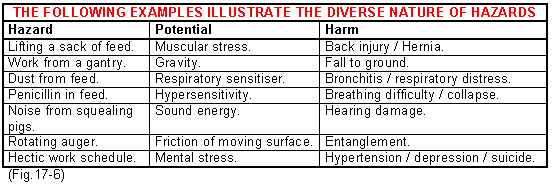
Identifying the hazards present on your farm is the first step in conducting risk assessments. Not many farmers have the expertise to identify all the hazards which is partly due to their familiarity with their own pig farms. The fresh eye of an independent specialist or that of a friend with experience of risk assessment and pig production can make a useful contribution at this stage.
The checklist Fig.17-7 gives some examples of common hazards on pig farms. It is a memory jogger to refer to when you are conducting risk assessments. The list is not exhaustive and you should add other hazards known to be present on your farm.
The fourth column on the check list, Fig.17-7 is headed Safety Data. The person conducting the risk assessments must have a knowledge of the harm that each hazard can cause. For some hazards you may need to refer to additional information. For example, you should obtain safety data for all of the medicines and chemicals used on your farm. In some countries it is a legal obligation to have such data available on site so that the information can be used in assessments and referred to for first aid advice in the event of exposure. The safety data that may be required for other hazards include such things as plant and machinery operating instructions and specifications that detail the machine operating performance limits, maximum load capacities, service requirements, safety test parameters, personal protective equipment required, and operator training requirements.
You will also need to know the legislative requirements regarding personal exposure limits for dust, noise and the various slurry gases, the required lighting levels for work areas and store rooms (the absence of light can constitute a hazard) - and anything else that would contribute to the assessment of the risks associated with the hazards identified.
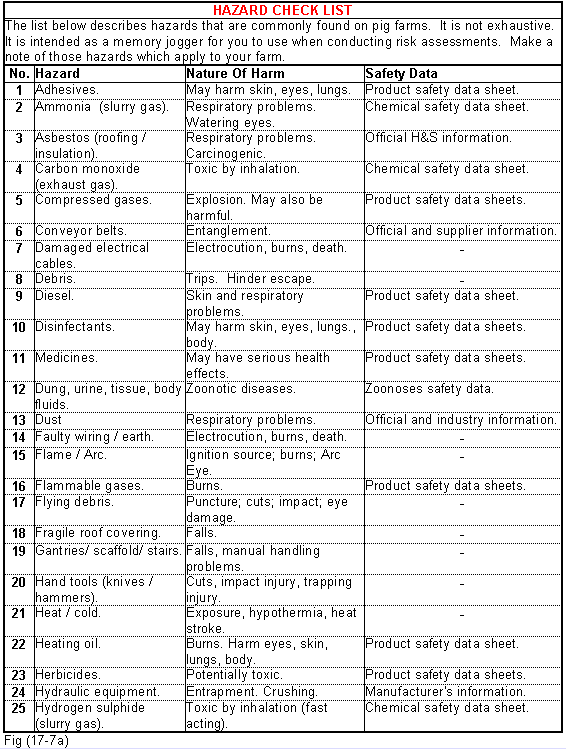
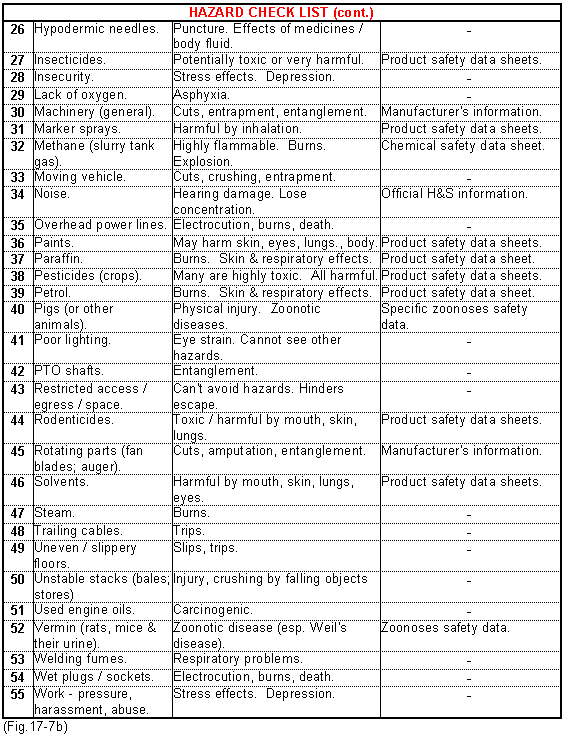
Zoonoses safety data
Zoonotic organisms are a
special type of biological hazard. They are the infections (bacteria, fungi,
parasites and viruses) that may be present in animals or their products which
can cause disease in people.
Information on the zoonotic organisms associated with pigs is given in Fig.17-8. Each one is a specific hazard with different properties and potential to cause harm. They should be evaluated individually.
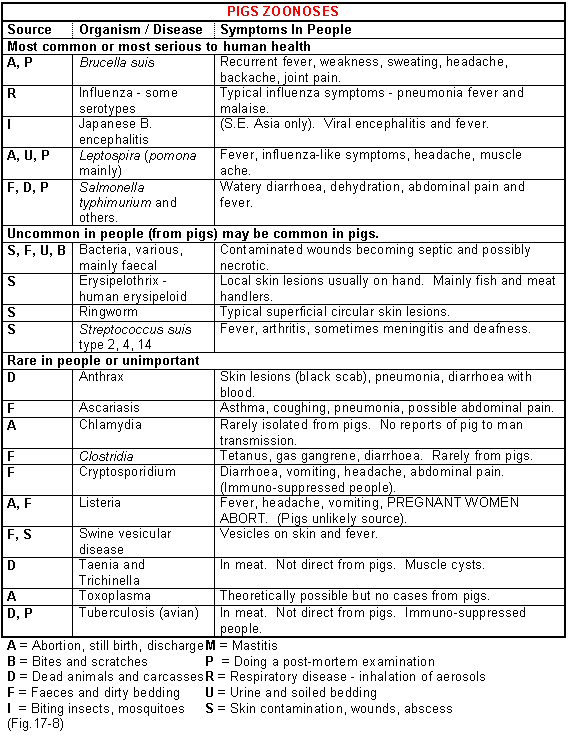
To help you put each in perspective the more common or serious ones are dealt with here. Fortunately there are relatively few serious zoonotic organisms in pigs and some of these are limited to particular regions.
Salmonella - Food poisoning is the most common world-wide, mainly Salmonella typhimurium but also from time to time other serovars including Salmonella enteritidis and Salmonella derby. The host adapted serovar in pigs, Salmonella cholerae-suis, rarely causes food poisoning in people but when it does it is serious. Food poisoning derived from pig meat products results from unhygienic handling and inadequate cooking and is not directly related to what you do on the farm unless you are selling pig products through a farm shop. From the viewpoint of health and safety salmonella are likely to be present on most pig farms but the levels are such that they do not normally present a hazard to farm workers. If clinical cases of salmonellosis occur in your pigs then the levels rise and become high enough to cause human disease. Everyone on the farm must then take hygienic precautions particularly before eating. Serological herd profiles are now developed and being used to monitor levels of pig exposure. The aim is to achieve category one, a very low exposure rate, by management methods that prevent transmission via faeces.
Campylobacter - Derived from animals are also a common source of food poisoning in people. Fortunately the majority of campylobacter found in pigs are not the same types that cause human disease (although some are) and pig products are not usually implicated. Nevertheless, you should be aware that they might be present in your herd and you should insist on strict hygiene when eating and drinking.
Leptospira - Some of the leptospira serovars in pigs, particularly Leptospira pomona, can cause a serious generalised infection in man, with fever and meningitis. Another called "Swine herds disease" or "Weil's disease" is caused by L. icterohaemorrhagiae. In pigs the main clinical signs are abortion, stillbirths and infertility. Fortunately L. pomona is now relatively rare in Northern Europe and North America and pig-derived disease in humans is uncommon but you should still be aware of it. The main source of infection to people is pigs' urine or vaginal discharges contaminating cuts (e.g. on the hands) or mucous membranes (e.g. the eyes or lips). Cuts should be covered and pigs' urine kept away from the face. The disease is amenable to prompt antibiotic therapy so if a person working on the farm comes down with fever, depression and headache call a doctor quickly.
Brucella suis - This is now rare in Northern Europe and North America but is more common in some other parts of the world. The main clinical effects are abortions, swollen testes and joint problems particularly of the spine. It causes a very serious disease in people and if it is suspected the greatest care should be taken not to contaminate cuts in the skin or mucous membranes such as the mouth or eye when dealing with aborted materials, vaginal discharges or cutting up a dead pig.
If your farm is in a region where Leptospira pomona or Brucella suis are prevalent then it would be a wise precaution to blood test your herd routinely to check that it is not infected and to get prompt veterinary diagnosis and advice if suspicious clinical signs occur.
Streptococcus suis serotypes 2, 4 and 14 - These are widespread in pig populations around the world and sometimes cause fever, joint problems, meningitis and deafness in people. Most people who become affected are people who handle meat. Cases in farm workers are rare. The number of people affected is tiny relative to the exposure rate that must take place so infection cannot be regarded as a high risk. Nevertheless, protective clothing, particularly rubber gloves. should be worm when carrying out post-mortem examinations and a doctor should be sought promptly if anyone should develop fever, dizziness and a headache. The disease is amenable to antibiotic therapy if treated early.
Some strains of the influenza virus can cross-infect between pigs and people sometimes causing clinical disease in both.
Japanese B. encephalitis - This is the most serious zoonotic infection of pigs. It is spread from pigs to people by mosquitoes. It is confined to herds in South East Asia and does not occur in Europe or the Americas. People working with pigs in endemic areas should be vaccinated.
Diseases in people caused by other potential zoonoses listed in Fig.17-8 is extremely rare and they warrant only brief mention here.
Anthrax - This is rare in pigs outside anthrax incubated areas. In such areas the disease is well understood and controlled.
Erysipelothrix rhusiopathiae - This is wide-spread in pigs everywhere causing the common pig disease erysipelas. The organism can (rarely) cause skin lesions in people usually on the hands but mainly in fish and meat handlers. (Note that the disease "erysipelas" in people is unrelated and is caused by a streptococcus).
Clostridium perfringens type A - This is common in pig faeces but poses little direct threat to pig workers. Food poisoning results from poor food preparation.
General safety precautions
- If a pig is exhibiting clinical signs of disease or it is in contact with diseased pigs and may be infected take the following precautions:-
- Cover cuts and abrasions with waterproof dressing.
- Wear gloves and coveralls.
- Disinfect gloves and coveralls after use.
- Always wash your hands after handling the animal or its products even if gloves were worn.
All staff involved with handling pigs or their excreta should be vaccinated against tetanus.
Pig zoonoses safety precautions are shown in Fig.17-8a.
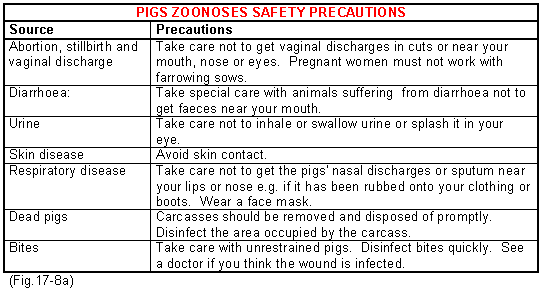
Risk rating
Determine whether the level
of risk associated with each of the hazards identified is high, moderate or
low. For risk assessments to be of greatest value you should adopt a risk
rating and priority system.
Risk has two components the likelihood of a harmful event occurring and the degree of damage if it should occur. If these two contributory factors are given numerical values, say from 1 to 3, the risk rating is the product of these values multiplied together.
From this it can be seen that the risk ratings will be 1, 2, 3, 4, 6 or 9 with 1 representing very high risk (very likely to happen. with severe consequences) and 9 representing negligible risk (unlikely to happen, slight consequences if it did). These risk rating values can be used to set priorities for actions. With 1 requiring immediate decisive action to eliminate or reduce the risk (i.e. very high priority and 9 requiring little or no action (i.e. very low priority). See Fig.17-8b.

Using a risk rating/priority system in your assessment will make it less likely that you ignore what you consider to be trivial risks. They may indeed turn out to be so but to show due diligence it is better that your assessment is recorded.
In order to determine the likelihood of a harmful event you have to make informed judgements based on:
- What hazards are present.
- What harm could they cause.
- Under what conditions they would be present in a form to cause harm and who would be affected (number of people, sex, health status).
- What precautions are already in place to prevent exposure.
The task of moving sacks of feed can be used to illustrate this point:
It is highly likely that a back injury will result if a slightly built person with no manual handling training has to carry a full sack of feed several times a day along a slippery walkway, up narrow steps to an unstable gantry and then raise the sack above the shoulders to tip it into the auger.
It is unlikely that a back injury will result if a strongly built person, trained in manual handling techniques, has to slide a sack of feed from a pallet, across a stable gantry then open the top of the sack and let the contents empty into the auger.
You should also consider your past accident/incident record and those of the pig farming industry in general. If you judge an event to be unlikely and yet such events have occurred on your farm or are common in the industry you should think again.
Statistics show that within any organisation there are likely to be many near miss incidents. These are accidents waiting to happen and many organisations now accept that risk assessments must also take account of these near misses.
Once you have decided on the likelihood of an event you can consider the consequences if that event should occur. When doing this you will need to take into account the number of people that could be affected and whether certain individuals would be more seriously affected than others because of an existing disability or medical condition. For example, the consequences of damage to an eye as a result say of using a grinding tool would be far greater for a person who is poorly sighted in one eye than it would be for a person with two good eyes.
In addition to the harm done to a person, consequential loss should also be included. For example if the person at risk is a key employee whose absence from work even for a short period would affect production, the risk rating should be higher than it would otherwise be.
You can see from these examples that this form of risk rating is not an exact science and you may need to modify it in order to give yourself more flexibility. For example, with certain hazards you may want to multiply in a third component by splitting up "consequences". Thus you could have three columns i.e.
Likelihood of event
Degree of harm to people
Consequential loss / cost
You would then have a wider range of scores, namely, 1 (the worse risk) 2, 3, 4, 8, 12, 18, 27 (the lowest risk).
It is important to recognise that this method of risk rating is not intended to give an objective quantitative measure of risk but rather to create a list of priorities and to provide a record that shows you have carefully considered likelihood and consequences.
Acceptable risks
Although the ideal situation
would be to eliminate all risks or reduce them to a trivial level this is
obviously not possible. Pig farming is a physical occupation involving manual
handling, potentially dangerous machines, potentially hostile environments and
large strong unpredictable animals. There will always be some risks associated
with it. With the emphasis now on self regulation, the onus is on you if you
are the employer to determine what the acceptable levels of risk are in your
situation and to be able to justify them.
This is summed up by your legal obligation (and policy) "to do all that is reasonably practicable to ensure the health, safety and welfare of all employees, contractors and visitors". The implications of the term "... do all that is reasonably practicable ..." are significant here.
Most employers appreciate that they are entitled to take cost and inconvenience into account when considering what actions would be required to reduce a risk unless the risk is high. Perhaps less well appreciated are other criteria that must also be taken into account.
The term "do all that is reasonably practicable" applies to both legislative and industry standards which means that you have to ensure that the levels of risk in your pig farm are at least within any specified legal limits and also that they are not significantly higher than those on other similar pig farms.
If other pig farmers are achieving fewer accidents and incidents than you, you cannot claim that it is not reasonably practicable for you to reduce risks also.
Therefore, before you can finally determine the appropriate control measures you have to find out what the legislative and industry standards are. This type of information may be available in Government publications and agricultural information bureaux or from the farmers trade association / union. You may have to compare notes with other pig producers and / or take advice from a consultant. You have an over-riding duty to exceed legislative and industry standards if it is reasonably practicable for you to do so.
The following three examples will hopefully put these points into context:
Example 1. Noise is a hazard that many pig producers consider 'goes with the business' and is therefore to be expected and accepted. Furthermore, because the effects of noise can take years to develop many farmers are not aware that the levels of noise on their farms may pose a significant risk to health. Consequently, the majority of farmers do not have a policy to reduce personal exposure to noise. The result, as surveys have shown, is that 25% of indoor pig workers have a noticeable hearing loss by the age of 30 and 50% have significant hearing loss by the age of 50.
Given these statistics it would be difficult for you to claim that it is not necessary or reasonably practicable for you to reduce it, particularly since control measures (using ear plugs at noisy times) would be simple and cheap to implement.
You probably do not have this option anyway because in many countries it is a legal requirement for employers to assess noise at work and if they think that there may be a risk to hearing, to measure the level of personal exposure to noise and if necessary apply controls to ensure that it is kept below legally defined limits. In this case you must control the risk. Cost and inconvenience only have a bearing on your choice of control measures.
Example 2. Back injuries are common in the pig industry and a certain level of risk is to be expected. But what level? Some countries have regulations stipulating that all manual handling activities must be assessed and that if risks are identified appropriate controls must be implemented. But they do not specify the levels of risk to be achieved other than that they must be as low as is reasonably practicable.
In this situation you must look to industry standards and your own records to provide a baseline for assessment. The pig industry may have set standards for, or national statistics may show, the average number of days lost per employee per year due to back injuries. If your record is worse than the standards or the national average, your employees and the enforcement agencies would be entitled to expect you to reduce the manual handling risks on your farm.
Example 3. Dust is another hazard associated with intensive pig production and not an easy one to cope with. The high levels present in many farms constitute a health and safety issue. More than 60% of all pig farmers suffer from dust induced respiratory problems during their working lives and in many cases these continue after they retire. The effects can be debilitating.
Research has attempted to determine the safe levels of exposure to dust and practical ways to control it. However, the complex make-up of piggery dust and the lack of long term clinical data make this a difficult task. Consequently, although occupational exposure limits (OELs) are specified in many countries they not only vary widely between countries but also refer to dust in general rather than to piggery dust specifically. Piggery dust has many potentially harmful components such as animal and feed proteins, bacteria and viruses, fungal and bacterial spores, mycotoxins and endotoxins. The reality is nobody knows the safe exposure levels for piggery dust which has implications for you as an employer. Although you may be able to achieve and demonstrate (by dust monitoring) levels of exposure to dust that are below the specified OELs (and any industry standards that apply), if any of your existing or past employees exhibit signs of respiratory problems (persistent cough, chest tightness, wheezing, shortness of breath, constantly runny nose, or sore throat) that are thought to be associated with the dust on your farm, you have to implement additional controls to further reduce the levels of personal exposure. Alternatively you must be able to justify why it is not reasonably practicable for you to do so.
All three of these examples highlight the need for you to keep abreast of the legislation, pig industry standards and general health and safety information. They also underline the importance of pre-employment and on-going health checks.
In the event of a criminal or civil claim being made against you, ignorance of the law is no defence.





